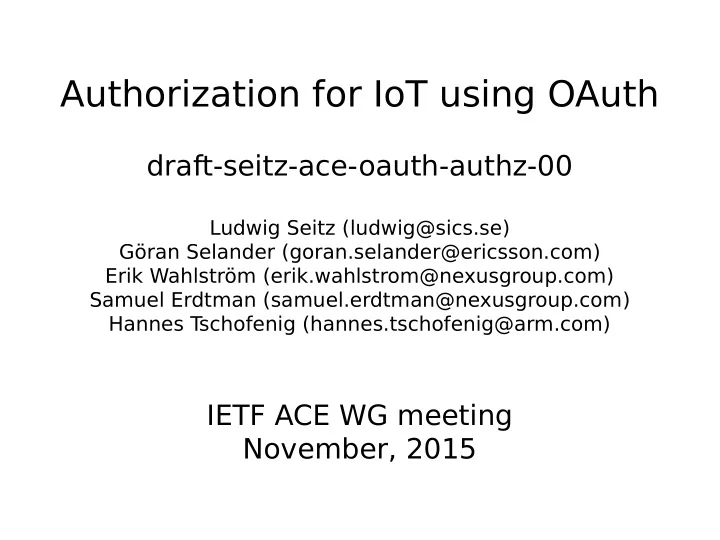

Authorization for IoT using OAuth draft-seitz-ace-oauth-authz-00 Ludwig Seitz (ludwig@sics.se) Göran Selander (goran.selander@ericsson.com) Erik Wahlström (erik.wahlstrom@nexusgroup.com) Samuel Erdtman (samuel.erdtman@nexusgroup.com) Hannes T schofenig (hannes.tschofenig@arm.com) IETF ACE WG meeting November, 2015
This draft • Merge of two proposals – ACRE • draft-seitz-ace-core-authz – OAuth • draft-tschofenig-ace-oauth-iot • draft-wahlstroem-ace-oauth-introspection 2
Design Principles 1) Allow security at difgerent layers 2) Allow difgerent authorization schemes 3) RESTful transfer of authorization information 4) (New!) Build on existing authorization protocols ● OAuth 2.0 (profjled for CoRE) ● Building blocks: CoAP, CBOR, COSE, OSCOAP 3
Basic OAuth Flow +--------+ +---------------+ | |---(A)-- Token Request ------------->| | | | | Authorization | | |<--(B)-- Access Token ---------------| Server | | | + Client Information | | | | +---------------+ | | ^ | | | Introspection Request & Response (D)| |(E) | Client | | v | | +--------------+ | |---(C)-- Token + Request ----------->| | | | | Resource | | |<--(F)-- Protected Resource ---------| Server | | | | | +--------+ +--------------+ • Difgerent deployment scenarios • Not all steps in every scenario 4
Profjling OAuth 2.0 for CoRE • AS support for setting up Communication Security – Establish security context and security protocol C ↔ RS • Resource for sending access tokens to RS – For provisioning the token independently of the request • Authorization Information Format – Interoperable format for access control data in tokens • CBOR instead of JSON – More compact tokens and client information • CBOR Web T okens – Compact variant of JSON Web T okens (JWT) → Enable the difgerent constrained scenarios 5
Example: RS has intermittent connectivity +--------+ +---------------+ | |---(A)-- Token Request ------------->| | | | | Authorization | | |<--(B)-- Self-contained Token -------| Server | | | + Client Information | | | | +---------------+ | | | | | Client | | | +--------------+ | |---(C)-- Token + Request ----------->| | | | | Resource | | |<--(F)-- Protected Resource ---------| Server | | | | | +--------+ +--------------+ Token needs to be self-contained, i.e. RS can evaluate it offline
Example: C has intermittent connectivity +--------+ +---------------+ | |---(A)-- Token Request ------------->| | | | | Authorization | | |<--(B)-- Reference Token ------------| Server | | | + Client Information | | | | +---------------+ | | ^ | | | Introspection Request & Response (D)| |(E) | Client | | v | | +--------------+ | |---(C)-- Token + Request ----------->| | | | | Resource | | |<--(F)-- Protected Resource ---------| Server | | | | | +--------+ +--------------+ ● A + B done when client has connectivity, e.g. at commissioning ● Token may be a reference (i.e. does not encode specific rights)
Advantages • OAuth already an IETF standard – Well-established – Widely deployed • Interoperable (Internet ↔ Internet of Things) • Compatible with existing IAM frameworks and policies already used with other OAuth deployments • Optimized to meet CoRE constraints 8
Next Steps • Details of OAuth profjling • Check integration with OMA LWM2M 9
Thank you! Questions/comments? 10
Recommend
More recommend